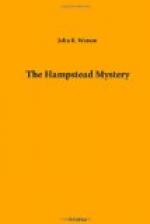The first witness called was Inspector Seldon, who gave evidence as to his visit to Riversbrook shortly before 1 p. m. on the 19th of August as the result of information received, and his discovery of the dead body of Sir Horace Fewbanks. He described the room in which the body was found; the position of the body; and he identified the blood-stained clothes produced by the prosecution as being those in which the dead man was dressed when the body was discovered. In cross-examination by Holymead he stated that Sir Horace Fewbanks was fully dressed when the body was found. The witness also stated in cross-examination that none of the electric lights in the house were burning when the body was discovered.
The next witness was Dr. Slingsby, the pathological expert from the Home Office who had made the post mortem examination, and who was much too great a man to be kept waiting while other witnesses of more importance to the case but of less personal consequence went into the box. Dr. Slingsby stated that his examinations had revealed that death had been caused by a bullet wound which had penetrated the left lung, causing internal hemorrhage.
Mr. Finnis, the junior counsel for the defence, suggested to the witness that the wound might have been self-inflicted, but Dr. Slingsby permitted himself to be positive that such was not the case. With professional caution he assured Mr. Finnis, who briefly cross-examined him, that it was impossible for him to state how long Sir Horace Fewbanks had been dead. Rigor mortis, in the case of the human body, set in from eight to ten hours after death, and it was between three and four o’clock in the afternoon of the day the crime was discovered that he first saw the corpse. The body was quite stiff and cold then.
“Is it not possible for death to have taken place nineteen or twenty hours before you saw the body?” asked Mr. Finnis, eagerly.
“Quite possible,” replied Dr. Slingsby.
“Is it not also possible, from the state of the body when you examined it, that death took place within sixteen hours of your examination of the body?” asked Mr. Walters, as Mr. Finnis sat down with the air of a man who had elicited an important point.
“Quite possible,” replied Dr. Slingsby, with the prim air of a professional man who valued his reputation too highly to risk it by committing himself to anything definite.




